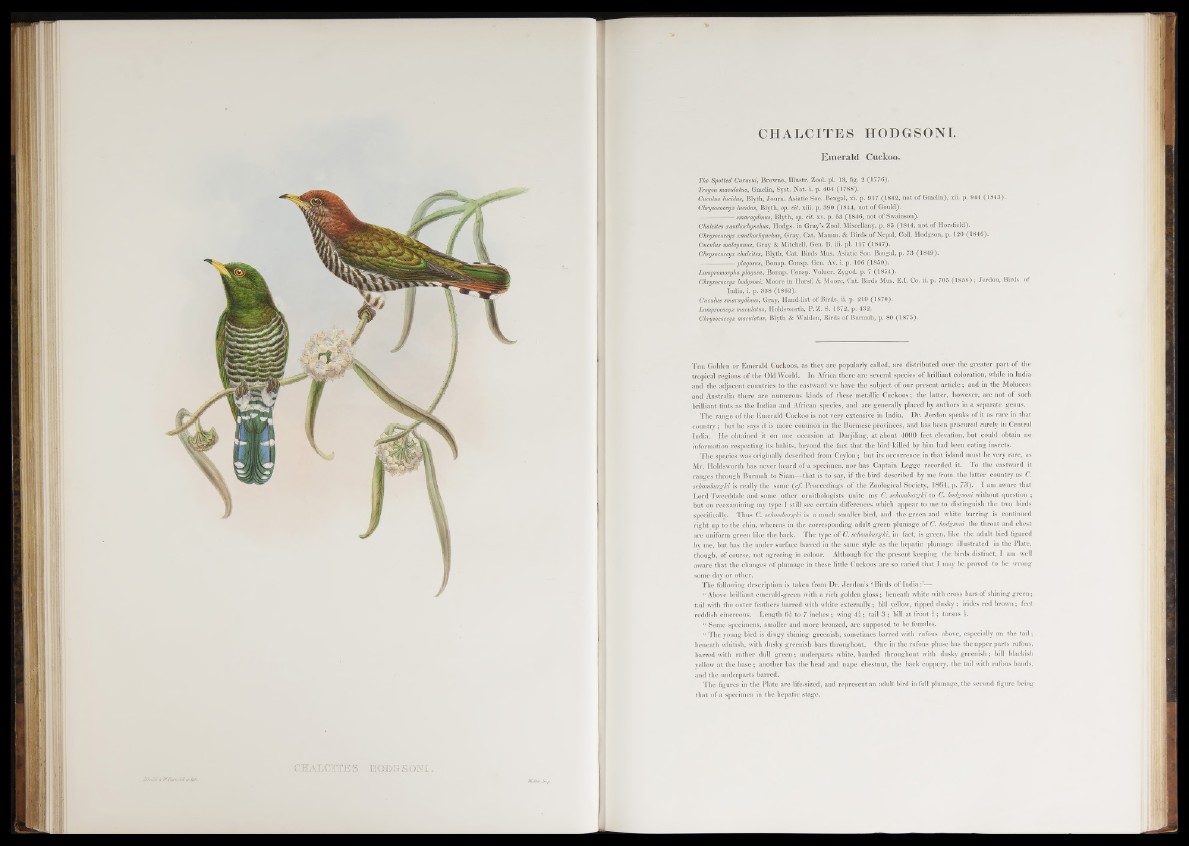
C H A L O T E S H O D G S O H I .
TVaha-Jnp.
CHALCITES HODGSONI .
Emerald Cuckoo.
The Spotted Curucui, Browne, Illustr. Zool. pi. 13, fig. 2 (1776).
Trogon maculatus, Gmelin, Syst. Nat. i. p. 404 (1788).
Cuculus lucidus, Blyth,, Joum. Asiatic Soc. Bengal, xi. p. 917 (1842, not o f Gmelin), xii. p. 944 (1843).
Chrysococcyx lucidus, Blyth, op. cit. xiii. p. 390 (1844, not of Gould).
----------------- smaragdinus, Blyth, op. cit. xv. p. 53 (1846, not of Swainson).
Chalcites xanthorhynchus, Hodgs. in Gray’s Zool. Miscellany, p. 85 (1844, not of Horsfield).
Chrysococcyx xanthorhynckus, Gray, Cat. Mamm. & Birds o f Nepal, Coll. Hodgson, p. 120 (1846).
Cuculus malayanus, Gray & Mitchell, Gen. B. iii. pi. 117 (1847).
Chrysococcyx chalcites, Blyth, Cat. Birds Mus. Asiatic Soc. Bengal, p. 73 (1849).
----------------- plagosus, Bonap. Consp. Gen. At. i. p. 106 (1850).
Lampromorpha plagosa, Bonap. Consp. Voider. Zygod. p. 7 (1854).
Chrysococcyx hodgsoni, Moore in Horsf. & Moore, Cat. Birds Mus. E.I. Co. ii. p. 705 (1 8 5 6 ); Jerdon, Birds of
India, i. p. 338 (1862).
Cuculus smaragdinus, Gray, Hand-list o f Birds, ii. p. 219 (1870).
Lamprococyx maculatus, Holdsworth, P. Z. S. 1872, p. 432.
Chrysococcyx maculatus, Blyth & Walden, Birds o f Burmah, p. 80 (1875).
T he Golden or Emerald Cuekoos, as they are popularly called, are distributed over the greater part of the
tropical regions of the Old World. In Africa there are several species of brilliant coloration, while in India
and the adjacent countries to the eastward we have the subject of our present article; and in the Moluccas
and Australia there are numerous kinds of these metallic Cuekoos ; the latter, however, are not of such
brilliant tints as the Indian and African species, and are generally placed by authors in a separate genus.
The range of the Emerald Cuckoo is not very extensive iu India. Dr. Jerdon speaks o f it as rare in that
country; but he says it is more common in the Burmese provinces, and has been procured rarely in Central
India. He obtained it on one occasion at Darjiling, at about 4000 feet elevation, but could obtain no
information respecting its habits, beyond the fact that the bird killed by him had been eating insects.
The species was originally described from Ceylon ; but its occurrence in that island must be very rare, as
Mr. Holdsworth has never heard of a specimen, nor has Captain Legge recorded it. To the eastward it
ranges through Burmah to Siam— that is to say, if the bird described by me from the latter country as C.
schomburghi is really the same (cf. Proceedings of the Zoological Society, 1864, p. 73). I am aware that
Lord Tweeddale and some other ornithologists unite my C. schomlurglci to C. hodgsoni without question ;
but on reexamining my type I still see certain differences which appear to me to distinguish the two birds
specifically. Thus C. sclomburgki is a much smaller bird, and the green and white barring is continued
right up to the chin, whereas in the corresponding adult green plumage of C. hodgsoni the throat and chest
are uniform green like the back. The type of C. schomburghi, in fact, is green, like the adult bird figured
by me, but has the under surface barred in the same style as the hepatic plumage illustrated in the Plate,
though, of course, not agreeing in colour. Although for the present keeping the birds distinct, I am well
aware that the changes of plumage in these little Cuckoos are so varied that I may be proved to be wrong
some day or other.
The following description is taken from Dr. Jerdon’s ‘Birds of In d ia |l|^
“ Above brilliant emerald-green with a rich golden gloss; beneath white with cross bars of shining green;
tail with the outer feathers barred with white externally; bill yellow, tipped dusky; irides red brown; feet
reddish cinereous. Length 6£ to 7 inches ; wing 4 i ; tail 3 ; bill at front f ; tarsus i.
“ Some specimens, smaller and more bronzed, are supposed to be females.
“ The young bird is dingy shining greenish, sometimes barred with rufous above, especially on the tail;
beneath whitish, with dusky greenish bars throughout. One in the rufous phase has the upper parts rufous,
barred with rather dull green; underparts white, banded throughout with dusky greenish; bill blackish
yellow at the base; another has the head and nape chestnut, the back coppery, the tail with rufous bands,
and the underparts barred.
The figures in the Plate are life-sized, and representan adult bird in full plumage, the second figure being
that o f a specimen in the hepatic stage.